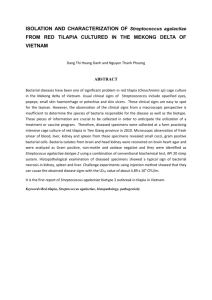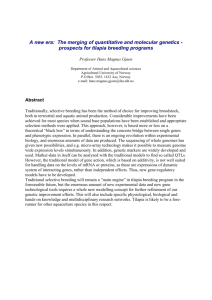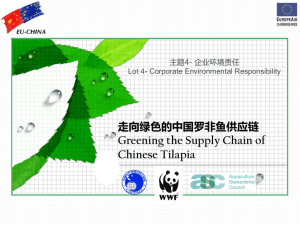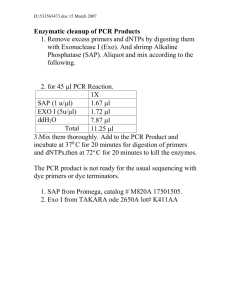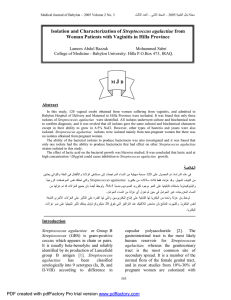Full text
advertisement
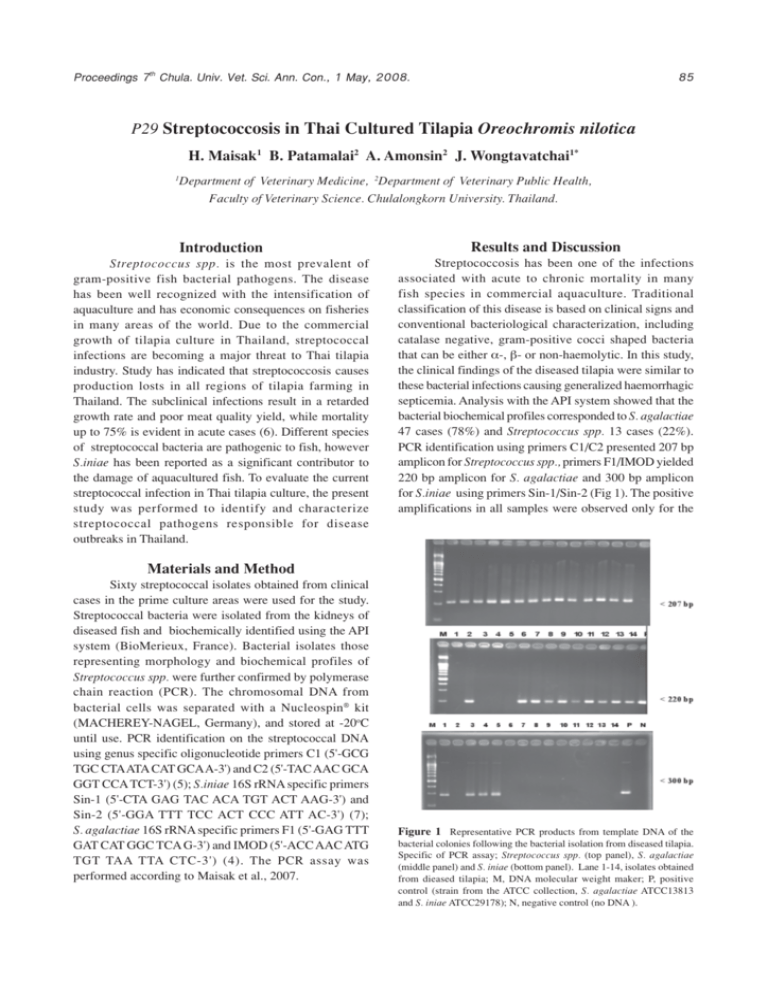
Proceedings 7th Chula. Univ. Vet. Sci. Ann. Con., 1 May, 2008. 85 P29 Streptococcosis in Thai Cultured Tilapia Oreochromis nilotica H. Maisak1 B. Patamalai2 A. Amonsin2 J. Wongtavatchai1* 1 Department of Veterinary Medicine, 2Department of Veterinary Public Health, Faculty of Veterinary Science. Chulalongkorn University. Thailand. Introduction Results and Discussion Streptococcus spp. is the most prevalent of gram-positive fish bacterial pathogens. The disease has been well recognized with the intensification of aquaculture and has economic consequences on fisheries in many areas of the world. Due to the commercial growth of tilapia culture in Thailand, streptococcal infections are becoming a major threat to Thai tilapia industry. Study has indicated that streptococcosis causes production losts in all regions of tilapia farming in Thailand. The subclinical infections result in a retarded growth rate and poor meat quality yield, while mortality up to 75% is evident in acute cases (6). Different species of streptococcal bacteria are pathogenic to fish, however S.iniae has been reported as a significant contributor to the damage of aquacultured fish. To evaluate the current streptococcal infection in Thai tilapia culture, the present study was performed to identify and characterize streptococcal pathogens responsible for disease outbreaks in Thailand. Streptococcosis has been one of the infections associated with acute to chronic mortality in many fish species in commercial aquaculture. Traditional classification of this disease is based on clinical signs and conventional bacteriological characterization, including catalase negative, gram-positive cocci shaped bacteria that can be either _-, `- or non-haemolytic. In this study, the clinical findings of the diseased tilapia were similar to these bacterial infections causing generalized haemorrhagic septicemia. Analysis with the API system showed that the bacterial biochemical profiles corresponded to S. agalactiae 47 cases (78%) and Streptococcus spp. 13 cases (22%). PCR identification using primers C1/C2 presented 207 bp amplicon for Streptococcus spp., primers F1/IMOD yielded 220 bp amplicon for S. agalactiae and 300 bp amplicon for S.iniae using primers Sin-1/Sin-2 (Fig 1). The positive amplifications in all samples were observed only for the Materials and Method Sixty streptococcal isolates obtained from clinical cases in the prime culture areas were used for the study. Streptococcal bacteria were isolated from the kidneys of diseased fish and biochemically identified using the API system (BioMerieux, France). Bacterial isolates those representing morphology and biochemical profiles of Streptococcus spp. were further confirmed by polymerase chain reaction (PCR). The chromosomal DNA from bacterial cells was separated with a Nucleospin® kit (MACHEREY-NAGEL, Germany), and stored at -20oC until use. PCR identification on the streptococcal DNA using genus specific oligonucleotide primers C1 (5'-GCG TGC CTA ATA CAT GCA A-3') and C2 (5'-TAC AAC GCA GGT CCA TCT-3') (5); S.iniae 16S rRNA specific primers Sin-1 (5'-CTA GAG TAC ACA TGT ACT AAG-3') and Sin-2 (5'-GGA TTT TCC ACT CCC ATT AC-3') (7); S. agalactiae 16S rRNA specific primers F1 (5'-GAG TTT GAT CAT GGC TCA G-3') and IMOD (5'-ACC AAC ATG TGT TAA TTA CTC-3') (4). The PCR assay was performed according to Maisak et al., 2007. Figure 1 Representative PCR products from template DNA of the bacterial colonies following the bacterial isolation from diseased tilapia. Specific of PCR assay; Streptococcus spp. (top panel), S. agalactiae (middle panel) and S. iniae (bottom panel). Lane 1-14, isolates obtained from dieased tilapia; M, DNA molecular weight maker; P, positive control (strain from the ATCC collection, S. agalactiae ATCC13813 and S. iniae ATCC29178); N, negative control (no DNA ). 86 Proceedings 7th Chula. Univ. Vet. Sci. Ann. Con., 1 May, 2008. corresponding bacteria. The PCR technique confirmed that all 60 isolates were streptococcal bacteria as indicated by the API system. Unlike the API analytical results, however, the PCR method showed the pathogenic streptococcal isolates investigated in the tilapia culture of Thailand were mainly S. agalactiae (53 cases, 88%) whereas S. iniae infections were found in 7 cases (12%) all of which were confined to culture facilities in the eastern part of Thailand. Apart from the production loss effected by the disease, fish streptococcosis caused by S. iniae has recently emerged as a threat to public health due to its zoonotic consideration (2). S. iniae infections have been reported in humans associated with the direct contact or handling of diseased fish, human infection in Thailand has not yet been reported. In this article, the PCR method to identify S. agalactiae and S. iniae in diseased tilapia has provided a distinguished report of S. iniae infection in tilapia culture in Thailand. Acknowledgment This study was supported by The National Bureau of Agriculture Commodity and Food Standards and The Graduate School of Chulalongkorn University. References 1. 2. 3. 4. 5. 6. 7. API Company. https://apiweb.biomerieux.com Lau et al. 2003. J. Clin. Microbiol. 41(3): 1004-1009. Maisak et al. 2007. Thai. J. Vet. Med. 37(1): 101. Martinez et al. 2001. Can. J. Vet. Res. 65: 68-72. Meiri-Bendek et al. 2002. J. Dairy Sci. 85: 1717-1723. The National Bureau of Agriculture Commodity and Food Standards (ACFS). 2006. Streptococcosis in Thai Cultured Tilapia Orochromis nilotica. Zlotkin et al. 1998. App. Env. Microbiol. 64: 4065-4067.
